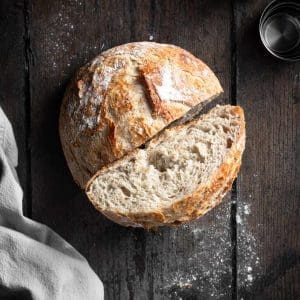No-Knead Whole Wheat Bread
Easy no-knead bread made with whole wheat flour. There's no kneading involved, all you need to do is to let the dough rise overnight. You have the option to make it as a sandwich loaf or a round loaf. Either way, this bread is hard and crusty on the outside and moist on the inside. It's the easiest healthy homemade bread you could ever make.
Servings 8
Ingredients
- 3 cups (400g) all-purpose whole wheat flour, spoon and leveled (see notes)
- 1/2 teaspoon instant yeast
- 1 teaspoon salt
- 1 1/2 cup water (room temperature)
- 1/2 cup seeds of choice, I like sunflower seeds and pumpkin seeds (optional)
Instructions
Prepare the Dough
- In a large mixing bowl, whisk together your flour, instant yeast and salt. Stir in the water until a thick dough forms, making sure all the flour is incorporated. Cover with a reusable bowl cover or plastic wrap and let it rise for 12 hours or overnight at room temperature.
The Next Day
- Preheat the oven to 450°F. Place a large enameled dutch oven in the oven while it preheats.
- Uncover the dough. At this point, it should be a lot bigger in size with some bubbles. Lightly flour a clean surface. With floured hands, scoop out the dough and place it on the floured surface. Form the dough into a ball, making sure the flour is incorporated (if using the seeds, incorporate them into the dough at this time). Place the formed dough on a piece of parchment paper. You can score the bread just before baking, but this is not necessary with this recipe.
- Once the oven is preheated, remove the dish from the oven and transfer the bread to the dish with the parchment paper. Bake for 30 minutes covered, then 15 minutes uncovered.
Bread Pan Method
- If making a sandwich loaf, prepare the dough in the same way and let it rise overnight, covered. The next day, preheat the oven to 450°F. Place a strip of parchment paper at the bottom of a bread pan and up the longer sides. You should be able to pick up both sides of the parchment paper to remove the bread later.
- Lightly flour a clean surface. With floured hands, scoop out the dough and place it on the floured surface. Form the dough into roughly the shape of the bread pan (if using the seeds, incorporate them into the dough at this time) and place it in the parchment-lined pan. Cover (I use a towel here) and let it rise until the oven is preheated or let it rise a few more hours if you have the time. Once the oven the preheated, bake the bread uncovered for 35 minutes.
Video
Notes
To avoid getting a soggy bread, let it cool on a cooling rack - This protects the bread from humidity that forms when left in the pan. Once the bread has cooled completely and has been sliced, store it covered, at room temperature.
You can make this recipe using all-purpose white flour if preferred. You can also use 1 cup of white flour and 2 cups of whole wheat flour. Bread flour also works. White flour will make this bread softer and more fluffy as expected.
You can score the dough just before baking if desired, but this is not necessary. The result will be the same, but scoring the dough (making a few slashes in the dough) can make it look pretty.
Do not measure the flour by scooping the measuring cup directly in the flour as you will end up using too much flour. Instead, use a spoon to scoop the flour, transfer it to the measuring cup, then level the flour using the back of a knife. You can also weigh the flour.
If the dough is too sticky the next morning after letting it rise, add a sprinkle of flour and knead the dough for a few minutes to incorporate the added flour. Repeat until you can form the dough into a ball, but avoid adding too much extra flour. It's normal for the dough to be a bit sticky. I've never found this to be necessary, but changes in measurement, room temperature and elevation might affect the texture of the dough.
I haven't tested a gluten-free option. If you want to try it, I recommend using a 1:1 gluten-free flour mix.
